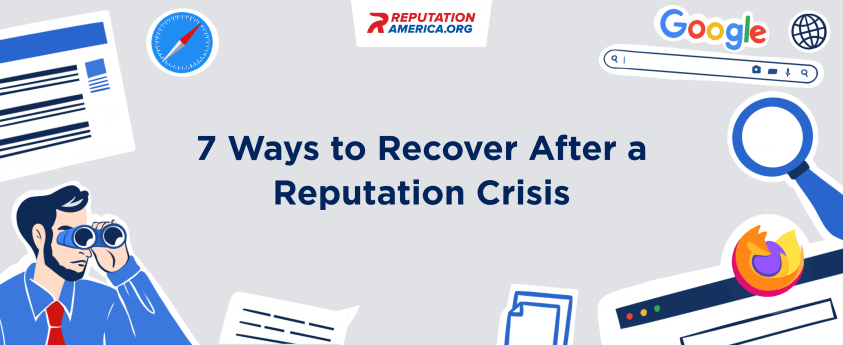7 Ways to Recover After a Reputation Crisis

Reputation damage is a risk for anyone in the public eye and many brand executives regard this as a top concern. Destruction of a company’s public image can cause a brand immense financial damage.
As a crisis plays out on the internet and social media, it can make recovery difficult. In some cases, it may even be necessary to scrub your internet presence entirely. In other cases, it is possible to minimize the effects of a crisis and rebuild a reputation.
Analyze the damage
To understand the level of the damage, it is necessary to quantify it. You will need to monitor the situation in Google search results and on social media platforms.
Other metrics like sales figures and share prices also provide insight into the extent of the crisis. To deal with the crisis, it is important to have all the facts at your disposal. Media analysis, focus groups, public opinion polls and surveys of stakeholders are all useful.
A detailed analysis of what is being said by media is important because this shapes perceptions. According to Harvard Business Review, a positive reputation requires at least 20% of the stories in leading media to be positive, no more than 10% negative, and the rest neutral. Being fully aware about what you’re facing will guide the way you respond to the crisis.
Using a dedicated online reputation management company can help you get to the root of the problem. At Reputationamerica.org, they specialize in the legal removal of negative content.
Agency has removed over 700 web pages with negative content, 2,000 negative reviews and other harmful information by using only legal methods. Illegal site interventions can leave a trace and make the problem worse.
Communicate with key stakeholders and investors
Communicating effectively with all stakeholders and investors post-crisis is a sign of resilience and transparency. You will first need to engage with internal stakeholders to share the impact of the crisis. They will need to understand how to move forward and how to take preventative steps to avoid the situation from recurring.
Communication with external stakeholders like business associations, regulators, supportive financial institutions etc., is necessary too. They need to understand what led to the crisis and what measures are being put into place to resolve it.
Twitter faced a crisis in 2019 when accounts of notable public figures were used for a cryptocurrency scam. Twitter Support had to inform all the affected users and the Twitter community about what had happened and how they were dealing with the situation.
Think carefully about your media strategy
You will need to decide whether you need to issue a press release or make a statement. When planning your media strategy, the following three situations may apply:
- If your brand is at fault, you need to acknowledge this and take ownership. Any attempt to pass the blame on to another party or conceal the truth is likely to make the situation worse. Delivering an apology shows the public that you recognize your failure and you are committed to solving the problem.
- If you are not at fault, you need to firmly state the truth.
- If an untruth was published online, you could seek a retraction but it is generally more helpful to ask the journalist responsible to apologize and share the truth.
Not every strategy leverages the media. In some cases, it may be better to pull away from public view altogether and not to say anything for a while.
Plan your social media response
Take control of conversations on your website, social media channels, review websites, and other online platforms. Starbucks did this when it issued a formal apology for a racist incident across all its social media channels and announced that it would close all its U.S.-company-owned stores in order to conduct racial-bias training.
After issuing any statement, you need to find out what people are saying about your brand and track all hashtags that feature it so you can respond quickly to any comments.
If you can show your online community that you care about the situation and are doing all you can to remedy it, it can help you to retain their trust.
Be authentic and positive
Acknowledging fault and being transparent about what you’re doing to fix a problem is important. Remember that your reputation is built on what you deliver and not on just making promises. Actions will always speak louder than words and you need to tackle any unacceptable activities, policies or failures head-on.
You also need to showcase the positives about your brand in all your content. Negative content probably caused the crisis and so you will need to work on relentlessly publishing positive content if you want all stakeholders to anticipate a better future and feel a sense of hope.
Some of the positive aspects you will need to convey are your accreditations, longevity, financial stability, positive feedback you received over the years from consumers, new ideas or products in the pipeline etc.
Use strategic influencers
A campaign using strategic influencers, such as policymakers, business thought leaders or even paid marketing influencers, could speed up your recovery. These influencers could help to rebuild trust with consumers and shift focus away from the crisis.
Social media can not only precipitate a crisis but make repairing it challenging. However, working it correctly can do a great deal to put things right again. Consumers are likely to trust what influencers they respect say more than what your brand has to say about itself.
Get respected third party endorsement
If a third party respected by stakeholders endorses a brand, this could also help with recovery. It could be the family patriarch who founded the business, a supportive business partner, or even a celebrity consumer with a dedicated social media following who uses your products or services. This positive endorsement could help to restore trust post-crisis and pave the way for a more positive future.
Conclusion
If you want to rebuild your reputation after a crisis, it takes a strong commitment and a solid strategy. In a highly competitive world, any brand can suffer a crisis and removing negative content can be a difficult process. A positive online reputation is crucial today and will help your business go from strength to strength. If you want to rebuild your reputation, the seven steps mentioned above will help you to do so and getting some professional help will be worth your while.

We will help you to improve your personal reputation and delete negative content legally
It’s free, confidential, and without obligation







This article does not have any comments. Be first to leave one.